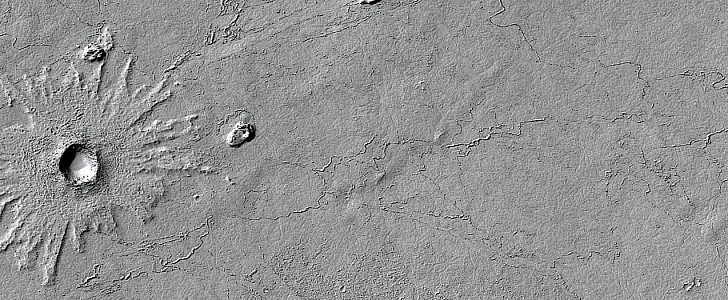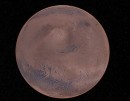We’ve been looking at photos of the Martian surface, trying to make some sense of it, for more than a year now, and during that time we’ve learned the neighboring planet truly is a wonderfully strange place. Going through its features is like riding an emotional rollercoaster, as each of the Martian images tells a different story.
Until now, none of the images we’ve featured told the story of something akin to art – at least, not the ones we know of, as it’ll probably take us years to go through them all. Sure, we got that degraded crater in the Utopia Planitia region, but that was about it.
The image we have here on the other hand seems to show one of those strange paintings no one really understands, but someone will always pay big bucks for. We’ve got a mostly undisturbed plain to cover the area, some outcroppings to the south, and what looks like one creative splash of something, the crown of the art piece, to the west.
Now, the plain is called Athabasca Valles, an outflow channel system (the youngest on the planet) located in the same Utopia Planitia area we talked about earlier. It may have formed either as a result of floodwater, low-viscosity lava, or glaciers, no one really knows.
Then, the outcroppings are akin to Earth’s intrapermafrost ice-cored hills, features we humans call pingos. As for the splash, well, that’s something the scientists looking at the photos from Mars call pedestal crater. That means an impact where the ejecta that resulted from it stands above the neighboring terrain, making the entire thing look like, well, a pedestal.
According to NASA, what we have here is a “nice little pedestal crater atop lava,” a feature that might “be able to tell us something about the history of mantling of the lava.”
This image was captured by the HiRISE camera in July 2021 from an altitude of 274 km (170 miles).
The image we have here on the other hand seems to show one of those strange paintings no one really understands, but someone will always pay big bucks for. We’ve got a mostly undisturbed plain to cover the area, some outcroppings to the south, and what looks like one creative splash of something, the crown of the art piece, to the west.
Now, the plain is called Athabasca Valles, an outflow channel system (the youngest on the planet) located in the same Utopia Planitia area we talked about earlier. It may have formed either as a result of floodwater, low-viscosity lava, or glaciers, no one really knows.
Then, the outcroppings are akin to Earth’s intrapermafrost ice-cored hills, features we humans call pingos. As for the splash, well, that’s something the scientists looking at the photos from Mars call pedestal crater. That means an impact where the ejecta that resulted from it stands above the neighboring terrain, making the entire thing look like, well, a pedestal.
According to NASA, what we have here is a “nice little pedestal crater atop lava,” a feature that might “be able to tell us something about the history of mantling of the lava.”
This image was captured by the HiRISE camera in July 2021 from an altitude of 274 km (170 miles).






